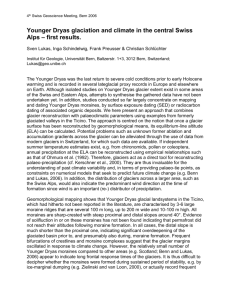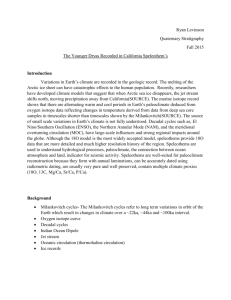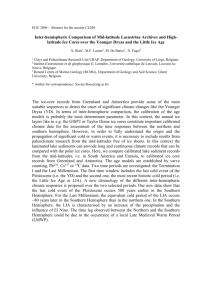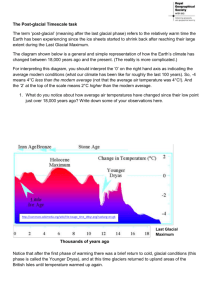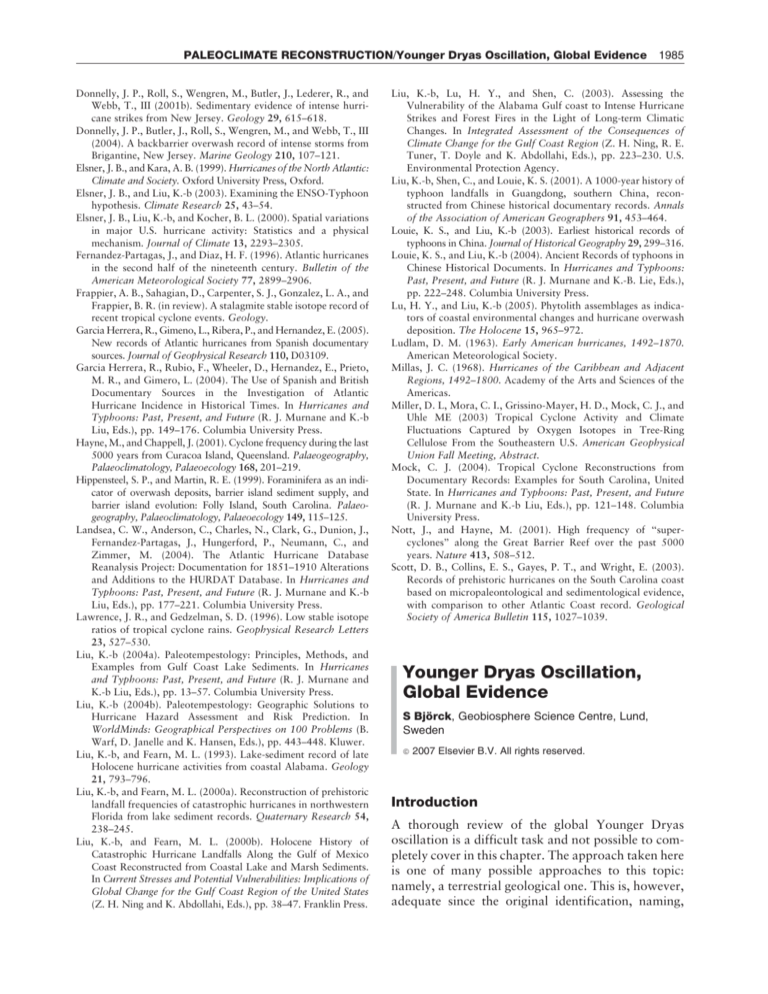
PALEOCLIMATE RECONSTRUCTION/Younger Dryas Oscillation, Global Evidence
Donnelly, J. P., Roll, S., Wengren, M., Butler, J., Lederer, R., and
Webb, T., III (2001b). Sedimentary evidence of intense hurricane strikes from New Jersey. Geology 29, 615–618.
Donnelly, J. P., Butler, J., Roll, S., Wengren, M., and Webb, T., III
(2004). A backbarrier overwash record of intense storms from
Brigantine, New Jersey. Marine Geology 210, 107–121.
Elsner, J. B., and Kara, A. B. (1999). Hurricanes of the North Atlantic:
Climate and Society. Oxford University Press, Oxford.
Elsner, J. B., and Liu, K.-b (2003). Examining the ENSO-Typhoon
hypothesis. Climate Research 25, 43–54.
Elsner, J. B., Liu, K.-b, and Kocher, B. L. (2000). Spatial variations
in major U.S. hurricane activity: Statistics and a physical
mechanism. Journal of Climate 13, 2293–2305.
Fernandez-Partagas, J., and Diaz, H. F. (1996). Atlantic hurricanes
in the second half of the nineteenth century. Bulletin of the
American Meteorological Society 77, 2899–2906.
Frappier, A. B., Sahagian, D., Carpenter, S. J., Gonzalez, L. A., and
Frappier, B. R. (in review). A stalagmite stable isotope record of
recent tropical cyclone events. Geology.
Garcia Herrera, R., Gimeno, L., Ribera, P., and Hernandez, E. (2005).
New records of Atlantic hurricanes from Spanish documentary
sources. Journal of Geophysical Research 110, D03109.
Garcia Herrera, R., Rubio, F., Wheeler, D., Hernandez, E., Prieto,
M. R., and Gimero, L. (2004). The Use of Spanish and British
Documentary Sources in the Investigation of Atlantic
Hurricane Incidence in Historical Times. In Hurricanes and
Typhoons: Past, Present, and Future (R. J. Murnane and K.-b
Liu, Eds.), pp. 149–176. Columbia University Press.
Hayne, M., and Chappell, J. (2001). Cyclone frequency during the last
5000 years from Curacoa Island, Queensland. Palaeogeography,
Palaeoclimatology, Palaeoecology 168, 201–219.
Hippensteel, S. P., and Martin, R. E. (1999). Foraminifera as an indicator of overwash deposits, barrier island sediment supply, and
barrier island evolution: Folly Island, South Carolina. Palaeogeography, Palaeoclimatology, Palaeoecology 149, 115–125.
Landsea, C. W., Anderson, C., Charles, N., Clark, G., Dunion, J.,
Fernandez-Partagas, J., Hungerford, P., Neumann, C., and
Zimmer, M. (2004). The Atlantic Hurricane Database
Reanalysis Project: Documentation for 1851–1910 Alterations
and Additions to the HURDAT Database. In Hurricanes and
Typhoons: Past, Present, and Future (R. J. Murnane and K.-b
Liu, Eds.), pp. 177–221. Columbia University Press.
Lawrence, J. R., and Gedzelman, S. D. (1996). Low stable isotope
ratios of tropical cyclone rains. Geophysical Research Letters
23, 527–530.
Liu, K.-b (2004a). Paleotempestology: Principles, Methods, and
Examples from Gulf Coast Lake Sediments. In Hurricanes
and Typhoons: Past, Present, and Future (R. J. Murnane and
K.-b Liu, Eds.), pp. 13–57. Columbia University Press.
Liu, K.-b (2004b). Paleotempestology: Geographic Solutions to
Hurricane Hazard Assessment and Risk Prediction. In
WorldMinds: Geographical Perspectives on 100 Problems (B.
Warf, D. Janelle and K. Hansen, Eds.), pp. 443–448. Kluwer.
Liu, K.-b, and Fearn, M. L. (1993). Lake-sediment record of late
Holocene hurricane activities from coastal Alabama. Geology
21, 793–796.
Liu, K.-b, and Fearn, M. L. (2000a). Reconstruction of prehistoric
landfall frequencies of catastrophic hurricanes in northwestern
Florida from lake sediment records. Quaternary Research 54,
238–245.
Liu, K.-b, and Fearn, M. L. (2000b). Holocene History of
Catastrophic Hurricane Landfalls Along the Gulf of Mexico
Coast Reconstructed from Coastal Lake and Marsh Sediments.
In Current Stresses and Potential Vulnerabilities: Implications of
Global Change for the Gulf Coast Region of the United States
(Z. H. Ning and K. Abdollahi, Eds.), pp. 38–47. Franklin Press.
1985
Liu, K.-b, Lu, H. Y., and Shen, C. (2003). Assessing the
Vulnerability of the Alabama Gulf coast to Intense Hurricane
Strikes and Forest Fires in the Light of Long-term Climatic
Changes. In Integrated Assessment of the Consequences of
Climate Change for the Gulf Coast Region (Z. H. Ning, R. E.
Tuner, T. Doyle and K. Abdollahi, Eds.), pp. 223–230. U.S.
Environmental Protection Agency.
Liu, K.-b, Shen, C., and Louie, K. S. (2001). A 1000-year history of
typhoon landfalls in Guangdong, southern China, reconstructed from Chinese historical documentary records. Annals
of the Association of American Geographers 91, 453–464.
Louie, K. S., and Liu, K.-b (2003). Earliest historical records of
typhoons in China. Journal of Historical Geography 29, 299–316.
Louie, K. S., and Liu, K.-b (2004). Ancient Records of typhoons in
Chinese Historical Documents. In Hurricanes and Typhoons:
Past, Present, and Future (R. J. Murnane and K.-B. Lie, Eds.),
pp. 222–248. Columbia University Press.
Lu, H. Y., and Liu, K.-b (2005). Phytolith assemblages as indicators of coastal environmental changes and hurricane overwash
deposition. The Holocene 15, 965–972.
Ludlam, D. M. (1963). Early American hurricanes, 1492–1870.
American Meteorological Society.
Millas, J. C. (1968). Hurricanes of the Caribbean and Adjacent
Regions, 1492–1800. Academy of the Arts and Sciences of the
Americas.
Miller, D. L, Mora, C. I., Grissino-Mayer, H. D., Mock, C. J., and
Uhle ME (2003) Tropical Cyclone Activity and Climate
Fluctuations Captured by Oxygen Isotopes in Tree-Ring
Cellulose From the Southeastern U.S. American Geophysical
Union Fall Meeting, Abstract.
Mock, C. J. (2004). Tropical Cyclone Reconstructions from
Documentary Records: Examples for South Carolina, United
State. In Hurricanes and Typhoons: Past, Present, and Future
(R. J. Murnane and K.-b Liu, Eds.), pp. 121–148. Columbia
University Press.
Nott, J., and Hayne, M. (2001). High frequency of ‘‘supercyclones’’ along the Great Barrier Reef over the past 5000
years. Nature 413, 508–512.
Scott, D. B., Collins, E. S., Gayes, P. T., and Wright, E. (2003).
Records of prehistoric hurricanes on the South Carolina coast
based on micropaleontological and sedimentological evidence,
with comparison to other Atlantic Coast record. Geological
Society of America Bulletin 115, 1027–1039.
Younger Dryas Oscillation,
Global Evidence
S Björck, Geobiosphere Science Centre, Lund,
Sweden
ª
2007 Elsevier B.V. All rights reserved.
Introduction
A thorough review of the global Younger Dryas
oscillation is a difficult task and not possible to completely cover in this chapter. The approach taken here
is one of many possible approaches to this topic:
namely, a terrestrial geological one. This is, however,
adequate since the original identification, naming,
1986 PALEOCLIMATE RECONSTRUCTION/Younger Dryas Oscillation, Global Evidence
and documentation of the Younger Dryas event was
carried out by Scandinavian Quaternary terrestrial
geologists and paleobotanists. In addition, the
Younger Dryas is still probably best manifested by
an often distinct lithologic change in lacustrine
records of western Europe (Fig. 1).
The concept that the late-glacial interval ended
with a distinct cold period originates from paleobotanical and lithostratigraphic studies of Swedish and
Danish bog and lake sites (Andersson, 1896); (Hartz
and Milthers, 1901), such as the Allerød clay pit in
Denmark (Hartz and Milthers, 1901). The term
‘Dryas’ refers to the occasionally abundant finds of
Dryas octopetala (Mountain Avens) leaves in these
often minerogenic-rich lake sediments. The prefix
‘Younger’ stems from the insight that the original
‘Dryas’ period was preceded by a warmer stage
(Allerød), which in turn was underlain by sediments
Figure 1 A section in a peat-bog in Schleswig-Holstein, northern Germany, dug out by Hartmut Usinger in Kiel. The thick light
grayish unit is a lacustrine sediment, clay gyttja, formed during the
Younger Dryas oscillation. The dark unit below is an organic-rich
sediment formed during the Bølling-Allerød warm period (GS-1),
and the unit above is Holocene gyttja and peat. Note the distinct
lower and upper boundaries of Younger Dryas, and for scaling the
spade in foreground.
implying at least another cold period (Hartz and
Milthers, 1901). With the onset of pollen analysis in
1916, the later refining of pollen analytical techniques and a steadily growing number of pollen diagrams it was obvious that the Younger Dryas
represented a distinct vegetational setback in large
parts of Europe, and during a time when a general
glacial–interglacial plant succession and immigration
took place. It was generally interpreted as an effect of
a sudden decrease in (annual) temperature, unfavorable for the previously rapidly spreading forest
vegetation. The cooling favored the expansion of
cold-tolerant, light-demanding plants, and led to
glacial advances and a lowering of the equilibrium
line altitude (ELA). This is clearly documented in, for
example, Norway, Sweden, and Finland by the
Ra-Middle
Swedish
endmoraines–Salpausselkä
moraine system, by glacier advances in the Alps,
and reglaciation in ice-free areas such as the northern
British Isles, Faroe Islands, and southern Sweden.
When carbon-14 (14C) dating became a general
dating tool, two of the Dryas periods, the Older and
Younger Dryas, were designated Nordic late-glacial
chronozones (Mangerud, et al., 1974), while the cold
period preceding the first late-glacial warming and the
Bølling Chronozone was often referred to as the
Oldest Dryas stadial. Based on a set of Scandinavian
14
C records the age of the Younger Dryas Chronozone
was set to 11,000–10,000 14C years before present
(BP). However, this Nordic nomenclature was soon
to become of global usage, although the rather
detailed climatostratigraphy upon which it was
based, was at that time rarely found outside Europe.
The research history of the late-glacial zones/periods is
summarized in (Björck, et al., 1998), who also suggested that the often inconsistent stratigraphic nomenclature of the late-glacial oscillations, including
Younger Dryas, should be termed events and be
defined by the Greenland Summit ice core stratigraphies. In this new scheme, the Younger Dryas corresponds to Greenland Stadial 1 (GS-1), and the original
Allerød warm period is defined as three events:
Greenland Interstadial-1c to 1a (GI-1c to GI-1a).
Although the Younger Dryas oscillation had been a
well-known feature among European Quaternary
geologists for almost a century, it was not until it
was ‘discovered’ on the North American continent
that it became a really ‘hot’ research topic. In spite of
reports of complex sediment lithologies in eastern
Canada and distinct pollen stratigraphic changes in
New England of late-glacial age, published at least
half a century ago, these findings were not regarded
as evidence for climatic oscillations. However, in the
mid-1980s, researchers began to relate these phenomena to a Younger Dryas cooling; old sites were
PALEOCLIMATE RECONSTRUCTION/Younger Dryas Oscillation, Global Evidence
reinterpreted in New England (Peteet, 1987) and in
eastern Canada (Mott, et al., 1986), and new sites
with a presumed Younger Dryas oscillation were
found (summarized by Wright, 1989). Mainly based
on marine evidence, Ruddiman and McIntyre (1981)
presented a model for oceanic Polar Front shifts during the last deglaciation, in which the Polar Front is
displaced far south (northern Spain) in the North
Atlantic around the same time as when the Younger
Dryas cooling in mainland Europe was presumed to
have occurred. The implication was that a large part
of the North Atlantic, and thus most of the European
Atlantic coasts, was shut off from warm Atlantic
waters and that the marine environment north of
the front was characterized by abundant icebergs
and sea ice. The lack of Younger Dryas records in
North America probably prevented the authors from
drawing the position of the front all the way to the
east coast of America. The Ruddiman-McIntyre
model of Polar Front shifts and Boyle and Keigwin’s
(1987) results from the Bermuda Rise showing
reduced North Atlantic deep water (NADW) formation during the Younger Dryas played an important
role for increased understanding of the late-glacial
climatic shifts, and perhaps especially of some of
the characteristics of and mechanisms behind the
Younger Dryas cooling.
In the late 1980s the evidence for a circum-North
Atlantic Younger Dryas cooling became more widely
accepted, and the common late-glacial climatic pattern
around the North Atlantic was clearly manifested by
the regional summaries of the North Atlantic Seaboard
Programme (NASP) of International Geological
Correlation Programme (IGCP) project 253 as well as
by the NASP synthesis (Lowe, et al., 1994).
The Northern Hemisphere Younger Dryas
With the overwhelming evidence of an amphi-North
Atlantic Younger Dryas cooling it became clear that
it must have had an impact over large regions, perhaps even a hemispheric or global influence
(Broecker, 1994). Its strong impact on North
Atlantic trade-wind intensity and regional precipitation patterns shown in the Cariaco basin of the tropical North Atlantic (Hughen, et al., 1996), was a
clear indication of its large influence on Northern
Hemisphere climate.
Possible Triggering Mechanisms Behind
the Younger Dryas
Changes in NADW and thermohaline circulation
(THC) were excellent mechanisms for explaining
the late-glacial climatic oscillations (Boyle and
1987
Keigwin, 1987), most clearly displayed in northwest European records where the North Atlantic
current has its strongest impact. However, the exceptionally long and severe Younger Dryas cooling,
compared with other late-glacial North Atlantic
coolings (Björck, et al., 1996), led to a special interest
in its underlying mechanisms. The idea that a sudden
fresh-water event triggered the onset of Younger
Dryas, such as the diversion of the outlet of Lake
Agassiz from the Gulf of Mexico to an eastern outlet
with a more or less catastrophic drainage through the
St. Lawrence River (Broecker, et al., 1988) and a
simultaneous Baltic Ice Lake drainage (Björck,
et al., 1996) into the North Sea, is a mechanism
that is supported by coupled atmosphere-ocean modeling (Manabe and Stouffer, 1988). A sudden
decrease in salinity in areas where NADW normally
occurs would have a rapid and disturbing effect on
the THC. This would seriously hamper the northwards meridional heat advection, and this model of
explaining the sudden onset and exceptional length
of the Younger Dryas has been widely acknowledged
as the most plausible mechanism for the onset of the
oscillation. The problem is, however, that it is only
based on circumstantial evidence; unless we can pinpoint the onset of such events to the very same year,
the link remains indirect. Furthermore, the Younger
Dryas Lake Agassiz drainage through the Great
Lakes has recently been questioned (Teller, et al.,
2005), but the last words on this topic are certainly
not written.
Timing of the Younger Dryas
The occurrence of a cold oscillation preceding the
warm Holocene in all the deep Greenland ice cores,
starting with the Camp Century core (Johnsen, et al.,
1972), became a strong support for those who
claimed that Younger Dryas was a significant climatic oscillation. The Greenland Summit ice cores
Greenland Ice Sheet Project-2 (GISP-2) and
Greenland Icecore Project (GRIP) imply that the
Younger Dryas lasted 1,150–1,300 years, depending
on which ice core is used for the determination
(Alley, 2000), and that it started around 12,800 ice
years BP. Likewise, the age of the end of the Younger
Dryas varies between different Greenland ice cores
and their different age models. However, the most
likely age seems to be 11,600–11,650 cal yr BP, and it
appears to have been synchronous over large parts of
the North Atlantic region (Björck, et al., 1996);
(Hughen, et al., 1996).
The suggested 14C age of 11,000–10,000 yr BP for
the Younger Dryas Chronozone (Mangerud, et al.,
1974) also meant that this 14C age usually was
1988 PALEOCLIMATE RECONSTRUCTION/Younger Dryas Oscillation, Global Evidence
period when 14C ages are roughly the same resulting
in declining D14C values. The new calibration curve
(Reimer, et al., 2004), and with the end of Younger
Dryas at 11,650–11,600 cal yr BP, shows that the last
200 years of Younger Dryas are characterized by a
gradual decline in 14C ages from 10,200 to 10,050
14
C yr BP (Fig. 2). At the transition a 200–250 year
long 14C plateau starts with 14C ages varying
between 10,050 and 10,000 14C yr BP; thus a 14C
age of 10,000–10,050 for the end of Younger Dryas
is presently the best estimate. The boundary now
seems to coincide approximately with the onset of a
14
C plateau, implying an increased global ocean ventilation rate; that is if carbon cycle changes and not
14
C production are responsible for this decrease in
D14C.
We can conclude that the Younger Dryas cool
event is bordered by distinct changes in the atmospheric 14C content. By comparisons with the beryllium-10 (10Be) record from ice cores, it shows that
the main part of these changes cannot be ascribed to
production changes, but must be related to variations
within the carbon cycle. Because of the large and
sudden changes, it is very likely that the largest carbon reservoir—the ocean—was a key player for these
variations. This is an additional indication that the
10,400
Radiocarbon years BP
assigned to the climatic oscillation. However, with
the advent of 14C accelerator mass spectrometry
(AMS) dating during the early 1980s it became possible to 14C date very small quantities (a few milligrams) of well-defined terrestrial organic material
(e.g., leaves and seeds) formed in direct contact with
atmospheric carbon dioxide. Previously the normal
type of dated material consisted of bulk sediment
material, prone to different dating problems such as
hard-water errors and reworked organic material.
With the increasing number of geologically ‘more
reliable’ AMS 14C measurements it became clear
that atmospheric 14C variations were considerable
during the millennia preceding the Holocene. In combination with the idea that the late-glacial oscillations were triggered by a varying strength of the
North Atlantic THC, and thus by changes in ocean
ventilation, these 14C variations were often interpreted as responses within the carbon cycle of atmosphere–ocean exchange processes. For example,
during the early 1990s an increasing number of
high-resolution 14C dates around the Allerød–
Younger Dryas boundary began to indicate that this
often distinct paleoclimatic change was difficult to
14
C date in detail; depending on which side of the
boundary the 14C samples originated from, ages
could vary between 11,000 and 10,600 14C yr BP.
Studies also showed that a 14C age of 11,000 years
BP clearly pre-dates the boundary, and that the first
(oldest) Younger Dryas 14C samples often obtain
ages of 10,700–10,600 14C yr BP (Björck, et al.,
1996). In fact, this very rapid age shift, which we
today know is a robust feature, could be used to
answer different questions and hypotheses about
Younger Dryas. Was this distinct rise in atmospheric
14
C content (D14C values) an effect of a severe disturbance in the North Atlantic THC resulting in
decreased (25–50%) ventilation between the ocean
and the atmosphere? If this was the case it could, for
example, imply that the onset of Younger Dryas was
characterized by a rapid spread of sea ice. In addition, the large 14C changes at this boundary are an
excellent time marker for evaluating if the event is
hemispherically and/or globally synchronous.
Although the end of the Younger Dryas was pragmatically set to 10,000 14C yr BP in the Nordic
chronostratigraphy (Mangerud, et al., 1974), the
majority of age estimates for the end of the climatic
cooling, often based on bulk sediment dates, was
usually centered around 10,200 14C yr BP.
However, with the possibility of AMS dating of identified macrofossils it gradually became clear that the
Younger Dryas–Preboreal transition around the
North Atlantic was characterized by a so-called 14C
plateau (Ammann and Lotter, 1989), i.e., a long
10,000
9,600
9,200
12,400
12,000
11,600
11,200
Calender years BP
Figure 2 Part of the radiocarbon calibration data set IntCal04
(Reimer et al., 2004), based on radiocarbon-dated tree rings from
German pines, between 10,500 and 9,500 14C yr BP. Each thin
vertical line on the curve shows a 14C age of a dated tree ring, and
the length of the line is the 14C dating error (1). The calibration
curve is compared to a set of 20 14C dates on terrestrial macrofossils from sediments in three south Swedish lakes (Björck et al.,
1996). The blue dates come from sediments formed just or
slightly before the Younger Dryas–Holocene boundary, and the
red dates are from sediments of very early Holocene age. The
vertical lines display the radiocarbon error (1) and the horizontal
lines show the calibration error (1). The dashed lines mark the
10,050–10,000 14C year plateau.
PALEOCLIMATE RECONSTRUCTION/Younger Dryas Oscillation, Global Evidence
Younger Dryas cooling was triggered by THC
changes and a varying strength of NADW.
Younger Dryas Records Outside the
Amphi-North Atlantic Region
In considering evidence for a Northern Hemisphere
Younger Dryas oscillation it is necessary to focus on
the huge North Pacific region. Several studies in this
region have shown that climate variability during the
last ice age cycle seems to have been very similar to
that reconstructed from terrestrial, ice core, and marine records in the circum-North Atlantic region.
These studies constitute marine and lacustrine sediments, speleothems, and loess profiles, ranging from
the west coast of North America/Central America to
Japan and up onto the Chinese loess plateau.
Although the chronologies for some of these records
have often been too poor for direct correlations to the
often better dated North Atlantic records, the climatic pattern seems very similar. It has, therefore,
often been stated that a direct link exists between
North Atlantic and North Pacific climates on millennial time scales. In fact, a Younger Dryas-like event
seems to be the last of these glacial suborbital climate
oscillations in the North Pacific region, but the exact
timing has usually not been possible to determine.
Although not very well dated, one of the first indications of a Younger Dryas event in the north-eastern
Pacific region came from a lacustrine study in southeastern Alaska (Engstrom et al., 1990), showing a
pine parkland being replaced by tundra. However,
the climatic ‘signature’ of this event is often very
different on both sides of the North Pacific. While
the Santa Barbara basin sediments became bioturbated (Kennett and Ingram, 1995) as an effect of
locally increased ventilation, the Japan Sea records
show a change to laminated sediments, possibly
caused by increased sea ice cover/anoxic conditions.
The Chinese speleothems and loess profiles suggest
an oscillating strength of the East Asian monsoon
system during the Last Termination, with a weakening of the Younger Dryas summer monsoon, explaining the more arid conditions during this time, and a
strengthening of the winter monsoon with increased
dust load from central Asia. The latter is seen in the
Greenland Summit ice cores. Uranium–Thorium (U–
Th) ages from Tangshan Cave in east China (Zhao,
et al., 2003) constrain the Younger Dryas fairly well
(12,500–11,540 yr BP), but indicate that the onset
and end of the Younger Dryas dry event in East Asia
may have been delayed in relation to the North
Atlantic. There are, however, other less well-dated
records in the desert-loess boundary area of northern
China implying more oscillating Younger Dryas
1989
conditions with tropical–polar interconnections
(Zhou et al., 2001). At Lake Suigetsu in Japan,
(Nakagawa, et al., 2003) the Last Termination in
East Asia has probably been studied in the most
detail. Its annually laminated sediments have been
14
C dated and pollen analyzed, and its pollen record
has been quantified in terms of mean annual temperature. The reconstruction shows a temperature
decline of 2–4 C between 12,300 and 11,250 yr BP,
based on the varve chronology, which implies a substantial delay at the onset and end of the Younger
Dryas in relation to the North Atlantic.
The atmospheric 14C signal is a global signal, with
a few decades of lag for the Southern Hemisphere. It
is therefore of interest to compare the set of 14C dates
at the onset and end of the Younger Dryas in Lake
Suigetsu with corresponding 14C dates in the North
Atlantic region. As noted above, the very onset of the
Younger Dryas is dated to 10,700–10,600 14C yr BP
on terrestrial macrofossils and tree rings in Europe,
after a shift from ca. 11,000 14C yr BP in less than
50 cal yr. The same shift is seen in the Lake Suigetsu
14
C record, but it predates Lake Suigetsu’s Younger
Dryas by a few hundred years. The Chinese and
Japanese data, therefore, confirm each other: the
Younger Dryas dry and cold event in East Asia lags
the North Atlantic Younger Dryas cooling with at
least 200–300 years. It is probable that the reason
behind this may lie in the often suggested ‘winter
dominance’ of the Younger Dryas climate, creatively
evaluated and reviewed by (Denton, et al., 2005).
Studies show that late-lasting Eurasian snow cover
will hamper the following summer monsoon by cooling down the land mass, decreasing the monsoon
driving temperature gradient between the sea and
the continent. The several hundred year-long transition into Younger Dryas, in Chinese and Japanese
records, could imply that the Younger Dryas cold
winter conditions in the North Atlantic region spread
eastwards on the Eurasian continent resulting in gradually longer and cooler winters, increasing the
intensity of the winter monsoon and gradually weakening the summer monsoon.
Similarly, if we compare the 14C ages at the end of
the Younger Dryas in Lake Suigetsu with the 14C ages
of the Younger Dryas–Preboreal transition around
the North Atlantic and around 11,600 cal yr BP in
the calibration data set, we can try to evaluate lags
between the records. In European detailed 14C
records, for example (Björck et al., 1996), Late
Younger Dryas 14C ages are greater than 10,000 yr
BP and rather around 10,100 cal yr BP, while the
early Preboreal 14C ages are usually not older than
10,100 yr BP (including 1), but rather around
10,000 yr BP (Fig. 2), a pattern which can be seen
1990 PALEOCLIMATE RECONSTRUCTION/Younger Dryas Oscillation, Global Evidence
in the calibration data set before and after 11,600 cal
yr BP. Because of the fairly large spread of the Lake
Suigetsu 14C dates at this time period a similar distinct pattern is hard to detect. However, it is impossible to shift the 14C dates of the transition in Lake
Suigetsu to more than 100–200 varve years older
ages, and therefore the notion of a delay of the
Holocene warming in Japan, and perhaps also in
other parts of East Asia, seems very likely. The scenario may be the same as for the delayed onset of the
Younger Dryas; the Eurasian continent was gradually
warmed from the west and the propagation of the
marine warming from the North Atlantic into the
Pacific Ocean took a few centuries.
The presence of a Younger Dryas-like oscillation in
the circum-North Atlantic and circum-North Pacific
regions would imply that it also occurs in the region
in between: North Africa and the Arabian Sea/northern Indian Ocean. Independent data sets show that
northern-equatorial Africa was dominated by arid
conditions during the time of the Younger Dryas:
lake levels fell in the west and east (Gasse, 2001),
and mountain forests were reduced. These mostly
arid conditions may have been related to decreased
intensity of the summer monsoon, which is supported
by evidence of decreased summer upwelling along the
Oman and Pakistan coasts during the Younger
Dryas; summer upwelling strength is closely linked
to the regional summer monsoon.
It is clear that the partial reorganization of the
climate system during the Younger Dryas had a fairly
substantial impact on the Northern Hemisphere climate, especially the winter conditions; both the
atmospheric and marine circulation pattern changed,
North Atlantic sea ice extended considerably, the
albedo increased, monsoon intensity decreased, and
atmospheric aerosols became more abundant, possibly most so in winter.
Is there Evidence for a Younger Dryas
Oscillation in the Southern Hemisphere?
Although the Younger Dryas was most likely triggered by changes in the North Atlantic, it would be
surprising if this event was not felt by the climate
system of the Southern Hemisphere; the large impact
of the Younger Dryas on the Northern Hemisphere
climate ought to have been propagated, in one way or
another, into some of the driving mechanisms for the
Southern Hemisphere climate system.
South America is probably the continent where
discussions about the presence or absence of a
Younger Dryas cold event have been most lively.
Most of these conflicting glacial, palynological, and
paleoentomological records are from Chile and
Argentina, but several records also exist from more
northerly areas such as the central Andes and in the
Amazon Basin (Clapperton, 1993). Paleoclimatic
interpretations of these data sets and the chronology
of the records seem to have been the two main obstacles for finding a common Younger Dryas signal. The
hitherto best dated series of South American cooling
events come from two sites at 41 S in Chile and
Argentina (Hajdas, et al., 2003) dated to ca.
11,500–10,200 14C yr BP (ca. 13,400–12,000 cal yr
BP). This implies that any South American equivalent
to the Younger Dryas overlapped half of the
European Allerød warm period and half of the
Younger Dryas cooling. It should, however, also be
remembered that the data sets analyzed and discussed, were formed during a climatically very
dynamic time period. Large differences should, therefore, be expected between the Amazon Basin at the
Equator and Tierra del Fuego in the south, the
Atlantic coast in the east, and the high Andes in the
west. The debate was also fueled by reports of welldated so-called Younger Dryas glacial advances in
New Zealand (Denton and Hendy, 1994) with
mean 14C ages of 11,000 14C yr BP. In light of the
already then existing knowledge that such ages predate the North Atlantic Younger Dryas cooling, it
would have been more appropriate to regard these
dates as evidence for ‘Allerød glacial advances in the
Southern Hemisphere.’ Time is also needed to buildup glacier ice and form the moraines. The concept of
pre-Younger Dryas glacial advances in New Zealand
is now generally accepted (Shulmeister, et al., 2005),
and detailed dating of a climate reversal in Kaipo
bog, with an age of 13,600–12,600 cal yr BP
(Hajdas, et al., 2006), shows that this cooling most
likely triggered any glacial advances.
Since the 1980s there have been indications that
Antarctic ice cores show a cold spell, the Antarctic
cold reversal (ACR), before the onset of the
Holocene. However, the exact timing of this event
has been uncertain due to difficulties with obtaining
sufficiently detailed chronologies for Antarctic ice
cores. It was regarded by many as a strong indication
for an Antarctic Younger Dryas, and as such also a
Southern Hemisphere one. However, when very
detailed methane (CH4) measurements of GRIP and
the Antarctic Vostok and Byrd ice cores were produced (Blunier, et al., 1997), it became obvious that
Antarctic and Greenland climatic changes are asynchronous, especially during glacial times (Blunier,
et al., 1998). With respect to the comparison between
the ACR and the Younger Dryas, the CH4 correlations have shown that the ACR began around 13,800
ice yr BP and ended at ca. 12,200 ice years BP in the
PALEOCLIMATE RECONSTRUCTION/Younger Dryas Oscillation, Global Evidence
Vostok ice core (Petit, et al.) Furthermore, the postACR rise in temperature occurred over ca. 600 years.
This implies that the ACR started ca. 1,000 years
before the Younger Dryas started in the Northern
Hemisphere, i.e., at the beginning of the Allerød
warming (GI-1c), and ended in the middle of the
Younger Dryas (Fig. 3). In fact, this type of climatic
development seems consistent with many other
observations in the Southern Hemisphere, such as
the New Zealand climatic reversal/glacial advances,
marine cores in the South Atlantic and Indian Ocean,
and records south of the equator on the Atlantic side
of Africa (Gasse, 2000). However, the Antarctic ice
cores do not give us a completely consistent picture;
the isotope stratigraphy of the Last Termination from
the Taylor Dome ice core is more similar to the
Greenland ice cores than are the other Antarctic
cores (Steig, et al., 1998). A warming peak is reached
at ca. 14,000 ice yr BP, which seems to be a normal
feature in Antarctic ice cores, followed by a gradual
cooling with minimum values at 12,900–12,300 ice
yr BP, which chronologically corresponds to the first
part of the Younger Dryas. At ca. 11,500 ice years BP
a sudden Holocene warming occurred, which is in
contrast to the long transition seen in the Vostok ice
core. It should, however, be pointed out that these
time differences may partly be explained by problems
in the various ice chronologies. It is also possible that
different regions of Antarctica responded in different
ways to the deglacial warming of the Last
Termination. Most of the currently available data
do, however, imply that the ACR began more than
1,000 years before the onset of the Younger Dryas in
the north, but not in direct ‘antiphase’ with the
Bølling-Allerød (GI-1) warming in the north. They
also imply that the start of the Holocene warming in
most Antarctic ice cores leads the warming in the
north with by at least 500 years.
The findings that warmings during glacial time in
Antarctic ice cores roughly coincide with cold periods over the Greenland Summit, and vice versa,
resulted in the hypothesis of a bipolar seesaw climate
pattern (Broecker, 1998). To what degree the
Younger Dryas and the ACR are part of this is difficult to judge, at least as long as the chronologies are
incomplete. Even before this hypothesis was formulated, climate models had shown that a breakdown of
the THC in the North Atlantic would result in a
warming of the Southern Ocean. Later models differed on how much such a warming would spread in
the Southern Hemisphere: to the entire hemisphere or
only to the South Atlantic and southern Indian
Ocean? Based on today’s knowledge it is, however,
tempting to conclude that (partial) breakdown of
THC and NADW in the North Atlantic, as a result
of sudden fresh-water discharges, resulted in a more
or less extensive warming during Younger Dryas time
in the Southern Hemisphere. In fact, it is also likely
that large parts of the Southern Hemisphere experienced a cold period (ACR) before its entry into the
Holocene warming, but clearly before the Northern
Hemisphere Younger Dryas.
10,000
10,000
11,000
11,000
12,000
Younger
Dryas
12,000
ACR
13,000
Ice years BP
1991
13,000
14,000
14,000
15,000
15,000
16,000
16,000
17,000
17,000
18,000
18,000
19,000
19,000
20,000
20,000
–40
–36
GRIP oxygen isotope ratios
–32
–8
–4
0
Vostok relative temperature
Figure 3 The GRIP oxygen isotope data (Johnsen et al., 2001) displaying temperature shifts over the Greenland Summit compared with
the relative temperature record from the Vostok station in Antarctica (Petit et al., 1999), between 20,000 and 10,000 ice yr BP. Ice years are
approximately the same as calendar years. The positions of the Younger Dryas and the ACR are indicated. Note that the timescale of the
GRIP data around Younger Dryas time is about 100 years too young when compared with the latest, but still unpublished chronology from
the NorthGRIP core.
1992 PALEOCLIMATE RECONSTRUCTION/Younger Dryas Oscillation, Global Evidence
Conclusions
We can conclude that the present interglacial, the
Holocene, was preceded by a distinct cool/dry event
in the Northern Hemisphere, generally designated
the Younger Dryas cooling or the GS-1 event in the
Greenland ice cores and dated to ca. 12,800–11,600
cal yr BP, and manifested by a winter dominated
climatic signature. In East Asia, there is good evidence that the onset and end of the event was slightly
delayed in relation to its North Atlantic counterpart.
It is likely that the event was triggered by rapid meltwater outbursts into the North Atlantic from the
Laurentide and Fennoscandian ice sheets.
In large parts of the Southern Hemisphere there is
clear evidence of a pre-Holocene cooling event. The
timing and character of this event are, however, less
clear. Most data indicate that it began 500–1,000 years
before its Northern Hemisphere equivalent and ended
at least 400 years before its termination around the
North Atlantic. This means that it overlaps most, or
at least the later part, of the Allerød warm period (GI1c–1a) and at least the beginning of the Younger Dryas
(GS-1) in the north. It also shows that the Holocene
warming began much earlier in the Southern
Hemisphere, during the peak of the northern Younger
Dryas cooling. It is difficult to judge to what extent this
pattern is part of a bipolar seesaw, but the transitional
overlap between northern–southern warming and cooling (Fig. 3) is reminiscent of the interhemispheric phase
lags during the Dansgaard/Oeschger cycles of glacial
time. A key question is of course: which hemisphere
leads? With respect to the Younger Dryas oscillation, it
is likely that a partial shutdown of the Atlantic conveyor belt decreased northern THC, which led to a
warming in the Southern Ocean, explaining the early
onset of the interglacial warming in the south. If we
postulate that fresh-water forcing in one hemisphere is
the main forcing mechanism for warmings in the other
hemisphere, the northern hemisphere Henrich-1 event
could have triggered the onset of warming in Antarctica
at 17,000 ice yr BP, and if melt-water peak-1A (Mwp1A) originated from Antarctica (Clark, et al., 1996) it
would imply that it triggered the Bølling warming
(Weaver, et al., 2003). Thus, the bipolar seesaw pattern
may be very complex, especially during phases of deglaciation, and the Younger Dryas oscillation is certainly
an important and globally significant part of the complexities of the Last Termination.
Abbreviations
ACR
AMS
BP
Antarctic cold reversal
accelerator mass spectrometry
before present
ELA
GISP
GRIP
GS-1
IGCP
Mwp-1A
NADW
NASP
THC
equilibrium line altitude
Greenland Ice Sheet Project-2
Greenland Icecore Project
Greenland Stadial 1
International Geological Correlation
Programme
melt-water peak-1A
North Atlantic deep water
North Atlantic Seaboard Programme
thermohaline circulation
See also: Ice Core Methods: Overview. Ice Cores:
History of Research, Greenland and Antarctica. Pollen
Analysis, Principles. Radiocarbon Dating:
Conventional Method.
References
Alley, R. B. (2000). The Younger Dryas cold interval as viewed from
central Greenland. Quaternary Science Reviews 19, 213–226.
Ammann, B., and Lotter, A. F. (1989). Late-Glacial radiocarbonstratigraphy and palynostratigraphy on the Swiss Plateau.
Boreas 18, 109–126.
Andersson, G. (1896). Svenska växtvärldens historia. P. A.
Norstedt & Söner, Stockholm.
Björck, S., et al. (1996). Synchronised terrestrial-atmospheric
deglacial records around the North Atlantic. Science 274,
1155–1160.
Björck, S., et al. (1998). An event stratigraphy for the Last
Termination in the North Atlantic region based on the
Greenland ice-core record: a proposal by the INTIMATE
group. Journal of Quaternary Science 13, 283–292.
Blunier, T., et al. (1997). Timing of the Antarctic cold reversal and
the atmospheric CO2 increase with respect to the Younger
Dryas event. Geophysical Research Letters 24, 2683–2686.
Blunier, T., et al. (1998). Asynchrony of Antarctic and Greenland
climate change during the last glacial period. Nature 394,
739–743.
Boyle, E. A., and Keigwin, L. D. (1987). North Atlantic thermohaline circulation during the past 20,000 years linked to highlatitude surface temperatures. Nature 330, 35–40.
Broecker, W. S. (1994). Massive iceberg discharges as triggers for
global climate-change. Nature 372, 421–424.
Broecker, W. S. (1998). Paleocean circulation during the last deglaciation: a bipolar seesaw? Paleoceanography 13, 119–121.
Broecker, W. S., et al. (1988). The chronology of the last deglaciation: implications to the cause of the Younger Dryas event.
Paleoceanography 3, 1–19.
Clapperton, C. (1993). Quaternary geology and geomorphology of
South America. Elsevier, Amsterdam.
Clark, P. U., et al. (1996). Origin of the first global meltwater pulse
following the last glacial maximum. Paleoceanography 11,
563–577.
Denton, G. H., and Hendy, C. H. (1994). Younger Dryas age
advance of Franz-Josef Glacier in the southern Alps of NewZealand. Science 264, 1434–1437.
Denton, G. H., et al. (2005). The role of seasonality in abrupt
climate change. Quaternary Science Reviews 24, 1159–1182.
Engstrom, D. R., et al. (1900). A possible Younger Dryas record in
Southeastern Alaska. Science 250, 1383–1385.
Gasse, F. (2000). Hydrological changes in the African tropics since
the last glacial maximum. Quaternary Science Reviews 19,
189–211.
PALEOCLIMATE RECONSTRUCTION/The Last Millennium
Hajdas, I., et al. (2003). Precise radiocarbon dating of Late-Glacial
cooling in mid-latitude South America. Quaternary Research
59, 70–78.
Hajdas, I., et al. (2006). Timing of the late-glacial climate reversal
in the Southern Hemisphere: a high-precision radiocarbon
chronology for Kaipo bog, New Zealand. Quaternary
Research 65, 340–345.
Hartz, N., and Milthers, V. (1901). Det senglacie ler i Allerød
tegelværksgrav. Meddelelser Dansk Geologisk Foreningen 8,
31–60.
Howell, T. V., et al. (2005). Testing the Lake Agassiz meltwater
trigger for the Younger Dryas. EOS 86, 365–375.
Hughen, K. A., et al. (1996). Rapid climate changes in the tropical
Atlantic region during the last deglaciation. Nature 380, 51–54.
Johnsen, S. J., et al. (1972). Oxygen isotope profiles through
Antarctic and Greenland ice sheets. Nature 235, 429–434.
Johnsen, S. J., et al. (2001). Oxygen isotope and palaeotemperature
records from six Greenland ice-core stations: Camp Century,
Dye-3, GRIP, GISP2, Renland and NorthGRIP. Journal of
Quaternary Science 16, 299–307.
Kennett, J. P., and Ingram, B. L. (1995). A 20,000 year record of
ocean circulation and climate-change from the Santa-Barbara
Basin. Nature 377, 510–514.
Lowe, J. J., et al. (1994). Climatic changes in areas adjacent to the
North Atlantic during the last glacial–interglacial transition
(14–9 Ka BP)—a contribution to IGCP-253. Journal of
Quaternary Science 9, 185–198.
Manabe, S., and Stouffer, R. J. (1988). Two stable equilibria of a
coupled ocean-atmosphere model. Journal of Climatology 1,
841–866.
Mangerud, J., et al. (1974). Quaternary stratigraphy of Norden, a
proposal for terminology and classification. Boreas 3, 109–128.
Mott, R. J., et al. (1986). Late-glacial climate oscillation in Atlantic
Canada equivalent to the Allerød/Younger Dryas event. Nature
323, 247–250.
Nakagawa, T., et al. (2003). Asynchronous climate changes in the
North Atlantic and Japan during the last termination. Science
299, 688–691.
Peteet, D. M. (1987). Younger Dryas in North America—modeling, data analysis, and re-evaluation. In Abrupt climatic
change: evidence and implications (W. L. Berger, Ed.),
pp. 185–193. Reidel, Dordrecht.
Petit, J. R., et al. (1999). Climate and atmospheric history of the
past 420,000 years from the Vostok ice core, Antarctica.
Nature 399, 429–436.
Reimer, P. J., et al. (2004). IntCal04 terrestrial radiocarbon
age calibration, 0–26 cal kyr BP. Radiocarbon 46, 1029–1058.
Ruddiman, W. F., and McIntyre, A. (1981). The North Atlantic
Ocean during the last deglaciation. Paleogeography,
Paleoclimatology, Paleoecology 35, 145–214.
Steig, E. J., et al. (1998). Synchronous climate changes in
Antarctica and the North Atlantic. Science 282, 92–95.
Shulmeister, J., et al. (2005). A cosmogenic nuclide chronology of
the last glacial transition in North-West Nelson, New
Zealand—new insights in Southern Hemisphere climate forcing
during the last deglaciation. Earth and Planetary Science
Letters 233, 455–466.
Teller, J. T., et al. (2005). Alternative routing of Lake Agassiz overflow
during the Younger Dryas: new dates, paleotopography, and a
re-evaluation. Quaternary Science Reviews 24, 1890–1905.
Weaver, A. J., et al. (2003). Meltwater pulse 1A from Antarctica as
a trigger of the Bølling-Allerød warm interval. Science 299,
1709–1713.
Wright, H. E., Jr. (1989). The amphi-Atlantic distribution of the
Younger Dryas palaeoclimatic oscillation. Quaternary Science
Reviews 8, 295–306.
1993
Zhao, J., et al. (2003). Speleothem U-series of semi-synchronous
climate oscillations during the last deglaciation. Earth and
Planetary Science Letters 216, 155–161.
Zhou, W., et al. (2001). Terrestrial evidence for a spatial structure of tropical-polar interconnections during the Younger
Dryas episode. Earth and Planetary Science Letters 191,
231–239.
The Last Millennium
M E Mann, Pennsylvania State University, PA, USA
ª
2007 Elsevier B.V. All rights reserved.
The period of roughly the last millennium is particularly important for characterizing the natural variability of the climate and, in so doing, framing
possible more recent anthropogenic climate changes.
Numerous natural archives or ‘proxy’ records, such
as tree rings, corals, ice cores, lake sediments, and
historical documents, are available to aid in reconstructing the details of climate changes within this
time frame (Fritts, 1976; Wigley et al., 1981; Jacoby
and D’Arrigo, 1989; Bradley and Jones, 1995;
Mann et al., 1998; Bradley, 1999; Huang et al.,
2000; Jones et al., 2001; Jones and Mann, 2004;
Luterbacher et al., 2004). Moreover, the basic external constraints on the climate system (the configuration of the continents, the extent of any continental
ice sheets, and the geometry of the Earth’s orbit) have
not changed appreciably on the millennial timescale.
For this reason, the variability of the climate over the
period of the past one or two millennia, but prior to
the past two centuries during which anthropogenic
impacts are likely to be a dominant factor, can provide insights into the envelope of natural variability
of the climate. These insights can, in turn, guide our
assessment of the extent to which recent climate
changes are anomalous and the extent to which
these changes are likely related to nonnatural (i.e.,
anthropogenic) impacts on climate.
A considerable body of scientific research in recent
decades has sought to characterize the nature of climate variability over the past millennium (Bradley
and Jones, 1995; Briffa et al., 2001). Numerous
groups have used proxy data to reconstruct this history of large-scale changes in temperature, precipitation and drought, and atmospheric circulation in past
centuries. These reconstructions place in a richer and
significantly more detailed context previous notions
of climate change embodied by terms such as the
‘Little Ice Age’ and ‘Medieval Warm Period.’ In particular, much of the climate variation in past centuries is characterized by a complex pattern of regional


